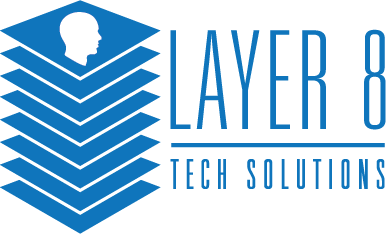Layer 8 Cloud Communication Services
Enterprise VoIP Services
Hosted voice over Internet protolcol services
By adding voice to a data network, you’ll reduce costs, improve productivity, and enhance collaboration. You can easily add, move, or change phone extensions and locations, which saves money and gives you more flexibility.
- Enable remote work with seamless access to the communication system from home or on-the-go
- Connect wirelessly with IP phones in warehouses, sales floors, or any data network-accessible location
- Experience enhanced collaboration through unified communications for small businesses
- Combine voice, video chat, web conferencing, and instant messaging for efficient teamwork
- Utilize individual or simultaneous communication technologies from a single, user-friendly interface

Standard Features
Experience the power and flexibility of our advanced VoIP solutions for businesses of all sizes.
Customer Portal - Web based user interface that allows users to manage their calling features, create call queues and groups, view call detail records and billing information, listen to and delete your voicemail, upload music on hold.
Top Level Auto Attendant (Always On) - Allows callers to select from menu options using a standard telephone keypad. Through the portal interface, calls can be routed to extensions, mailboxes, groups, conference rooms, call queues, or unlimited depths of additional auto attendants.
Multiple Top-Level Auto Attendants (Always on) - Allows for separate telephone numbers to be routed to unique Top-Level Auto Attendants. Each Auto Attendant is configurable individually.
Top Level Auto Attendant (Time Based) - Available after N rings or based on time of day.
Sub-Level Auto Attendants - Sub-Level Auto Attendants are often used for different departments within an organization. For instance, you may have a main Auto Attendant for the company, and then a sub-level Auto Attendant for Sales, Support, etc.
Find Me (Digital Assistant) - Setup a personal assistant to “find you” at up to five (5) Locations. This feature is configured per extension and offers an extensive number of options to route calls once they have reached the given extension Callers are asked to “announce themselves” and are offered the option between locations to try the next location, or to leave a message.
Call Hold - Place calls on hold and play music or a commercial on hold.
Attended Transfer - Transfer a call to an extension, group, or phone number AFTER announcing the party being transferred.
Unattended Transfer (Blind Transfer) - Transfer a call to another extension, group, or phone number WITHOUT announcing the party being transferred.
Call Forwarding - Forward calls via the Portal, or via your device or SoftPhone. Calls may be forwarded to any extension or phone number. Device or SoftPhone forwarding functionality may vary by manufacturer.
No Answer Call Forwarding - Automatically forwards your calls to an extension, group, or phone number when you do not answer your phone.
Busy Call Forwarding - Automatically forwards your calls to an extension, group, phone number when your phone is busy.
Incoming Call Blocking - “Black list” phone numbers to block them from calling your PBX.
Incoming Privacy Screening - Force callers with “no caller ID” or “blocked caller ID” to enter a number that will be presented as their caller ID.
Incoming Caller ID Routing - Route calls from a unique DID or phone number to any auto attendant, extension, group, phone number, or ACD or Call Queue.
Incoming DID Routing - Route calls based on the number that was dialed. Calls may be routed to an auto attendant, extension, group, phone number, or ACD or Call.
Outgoing Call Blocking - Prevent calls to specific numbers or services (ex: 900 calls).
Incoming Call Identification - Identify an incoming call on the phone’s LCD display by modifying the Caller ID display indicating how the call was routed.
One Button Redial - A device or SoftPhone feature that redials the last number dialed by the extension user. Not all phones support this feature.
Do-not-disturb (DND) - A device or SoftPhone feature that simulates a phone being off-hook, sending calls received directly into voicemail. Other routing options are also available.
Call Waiting Indicator - Indicates incoming call (and caller ID, if available) while another call is in process.
Automatic Call Distribution (ACD) - Used to route calls in a call center environment to the appropriate agents, based on factors such as time availability, behavior, and priority levels.
Call Queue - Call queues are used to route calls in a first-in-first-out manner to the appropriate extension or group. These extensions can be agents logged into the system. Call Queues are commonly used with an ACD, where the callers hear an announcement that says something like “thank you for calling, all available agents are busy, you are Nth caller. Estimated wait time is N minutes. Please hold for the next available agent or press N to leave a message. When the call is ready to be routed, the ACD handles the routing rules.
Call Routing Based on Business Hours, After Hours & Holiday Hours - Allows routing decisions based on time and date. Multiple schedules can be configured, as in the case of departments with different hours of operation.
Speed Dial - A device or SoftPhone feature that automates the dialing of a pre-determined phone number.
Company Wide Directory - A list of contacts and phone numbers that are uploaded via the Portal and are made available on an IP phone or SoftPhone. Forward your calls Locally or Remotely via Phone or Web Call forwarding is easy to setup and manage.
Caller ID Blocking - Disable Caller-id for all outbound calls made from your PBX.
DISA (Direct Inward System Access) - Allows someone from outside the PBX to obtain a dial tone and to place calls from it as if they were placing a call from within the switch (with password protection).
Office Intercom - Dial another user’s extension, activating their phone speaker to make an announcement.
Disable Outbound Dialing - Disable Outbound Dialing on certain extensions only.
3-Way Conference Call - After making or receiving a call, a user may conference in any third party for a 3-way call.
Conference Bridge - Multiple on-site and outside callers can simultaneously participate in password protected conference calls. Callers can be assigned talk-listen or listen only access.
Default Music On Hold - Royalty free music provided by.
Custom Music On Hold - Music provided by Customer, and uploaded through the Customer Portal.
Commercial On Hold - Record your commercial and upload it to your PBX via the Portal.
Commercial On Hold By Location or Queue - Multiple commercials on hold may be uploaded to your PBX, and can be unique based on location or queue.
Call Detail Records - Real-time call logging is available via the portal. From, to, call duration, date and time, and call type (International, Toll free, etc.). In addition, frequently called numbers can 'tagged' with text descriptions for legibility.
- Call volume graphs by time of day, month, year or custom dates Histograms
- Graphically display calling patterns and trends
- Call traffic by extension - Track number of calls by individual
- Detailed Accounting - Track orders, invoices, and all billings online
Call Recording - Selectively record calls for training or documentation purposes.

There are a multitude of reasons why switching to VoIP makes a lot of sense.
For consumers, the primary driver is cost savings and increasingly, people are opting to rely on mobile devices or mobile VoIP apps rather than landlines. However, business organizations must balance a variety of factors when upgrading to new technology. An enterprise must calculate the total cost of ownership for any new project including the initial, upfront investment as well as ongoing monthly maintenance expenses. Businesses can’t afford to take risks on new technology if it has not been proven or standardized. It is understandable that many organizations would wait before switching over to VoIP completely. With every passing year, the list of VoIP benefits keeps growing along with the pace of VoIP adoption among enterprises. So why should any business consider switching to VoIP?
VoIP Is Here to Stay
During the early days of VoIP, there were legitimate concerns regarding the long-term viability of the new technology. Quite a few companies may have dismissed VoIP as just a passing fad or as a system that is only suitable for a few businesses in certain industries.
VoIP Improves Productivity
Suppose an organization still has a functioning phone system and is highly profitable, maybe they do not see the need to cut costs. Even companies in such situations are increasingly transitioning to VoIP because the technology offers immense benefits in terms of collaboration, productivity and efficiency.
Many employees use work issued or personal mobile devices for business purposes and the use of third-party/native VoIP clients means that employees remain accessible even if they’re not at their desk.
VoIP Is Efficient
Since VoIP routes voice calls over the data network that is already being used by the organization to transmit other forms of media, it eliminates the need to maintain two separate networks.
VoIP Brings New Enterprise Features
Since VoIP is based on the Internet rather than telecommunication standards, innovative new features are incorporated into the technology on a regular basis.

Are you ready to revolutionize your IT experience?
Contact us today for a free consultation and let Layer 8 Tech Solutions revolutionize your IT experience.
